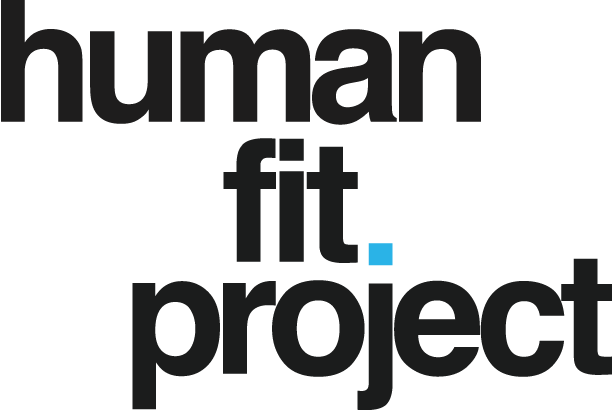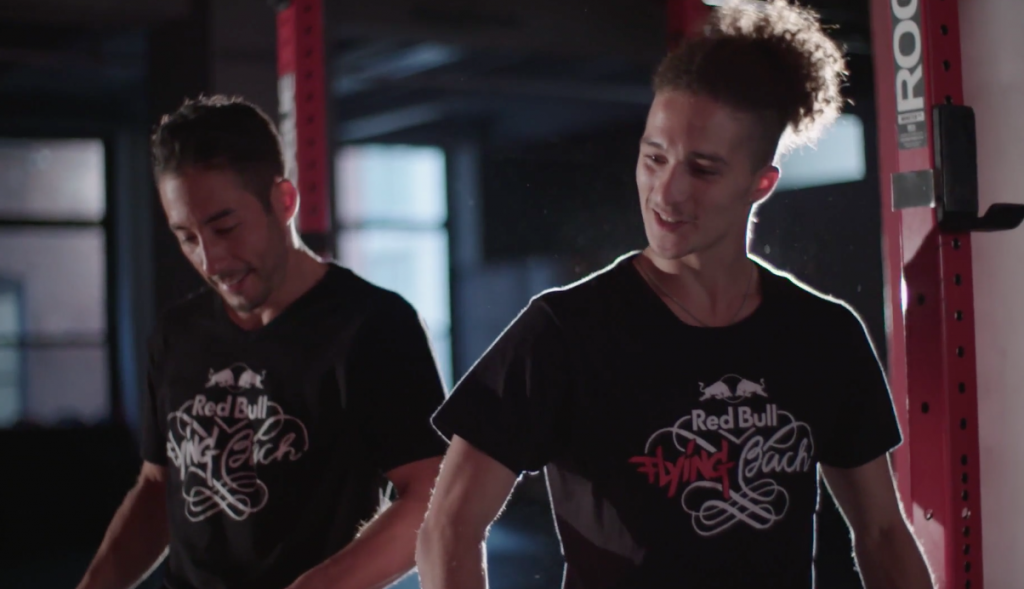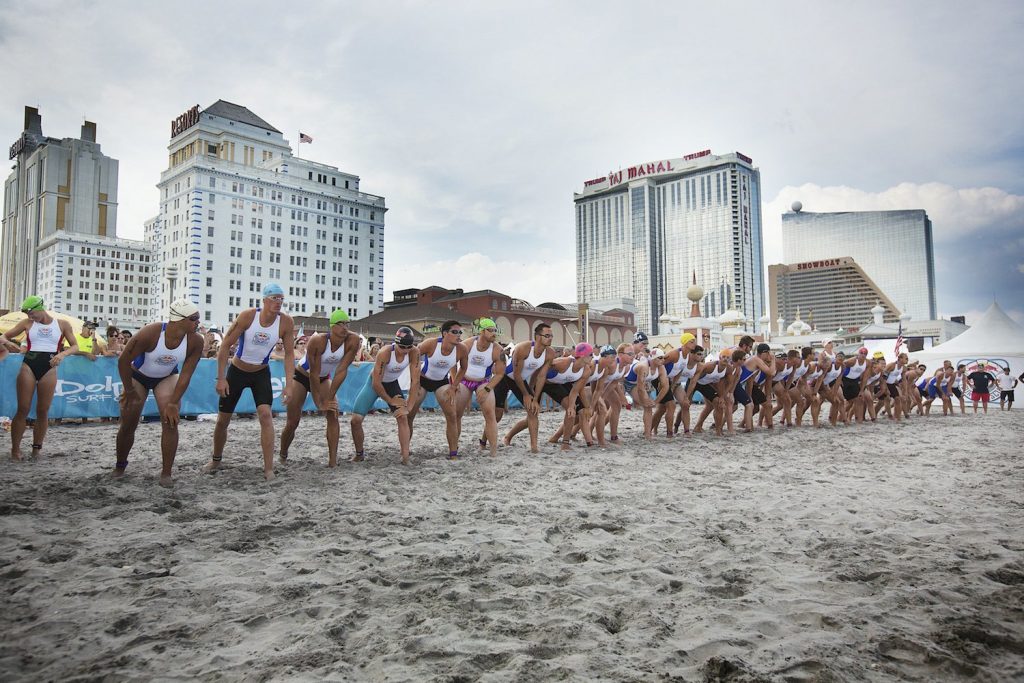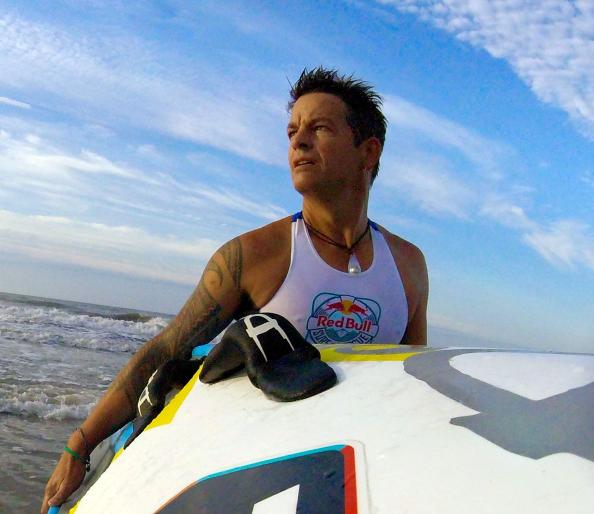For most of us, running or cycling for two miles is nothing. But swimming through currents and tides and unpredictable swells is an entirely different animal. On September 27th, actor Adrian Grenier will be joining Richard Branson to do just that. The two will swim across the Strait of Messina between Italy and Sicily. Why? Branson is doing this as a part of the 2016 Virgin Challenge; Grenier is doing it to support his own cause: The Lonely Whale Foundation.
While rumor has it Branson’s already in training, Grenier has tapped endurance waterman and Red Bull’s Surf+Rescue Technical Director, Bruckner Chase. We chatted with Chase about what it’s like to spend hours physically exerting yourself, putting the strongest lifeguards in New Jersey to the test, and how he plans to whip Grenier into shape.
Who is Bruckner Chase?
Back in ‘98, Chase ran for over 26 hours spanning 100 miles in Vermont, and swam for 14 hours and 28 miles across Monterey Bay in California. But dominating the water didn’t always come easy from a guy who grew up in the landlocked Memphis, Tennessee. “My first connection to the ocean was in Destin, Florida, and I was terrified of it,” he says. But after moving out to North California and falling in with the right crowd of ocean-enthusiasts, Chases’ passion for swimming and the ocean matured. “The best way to get over fear of being out there is to go with people that know the water, that are confident and strong swimmers. I became a better swimmer and met people that guided me through some really good experiences in the ocean.”
The North Shore of Oahu—An Introduction to “The Proving Grounds”
Chase didn’t even consider himself an “athlete” at that point. He never competed in anything at a young age, and didn’t play competitive sports aside from being a runner in high school. That all changed for him once he was convinced to do a marathon. “As soon as I did that for the first time, I realized that maybe I could do more than I thought. That my perception of myself as not being an athlete might have been wrong,” he says.
Now, 50-year-old Chase is still dialed in and keeping the fire alive. He says that being in the water for long distances and long periods of time is a huge internal conversation. “I’m constantly evaluating, ‘how do I feel?,’ ‘how’s my shoulder?,’ ‘how’s my stroke…” It’s that level of mind-body connection that gets him through. (Which will be a critical piece for Grenier, too.)
Today, while still a competitor, Chase is also involved with Red Bull Surf+Rescue Lifeguard Competition. Every summer in New Jersey, 40 teams of four compete for the title of the strongest surf rescue patrol. (This year, the event happened on July 19th—the win went to Longport Beach Patrol.) Red Bull had the idea to showcase the culture and community of the Jersey Shore, from south to north, the birthplace of beach patrol. They tapped Chase for help and to create the intense competition format. “We wanted to highlight the diverse skillset, the incredible conditioning, and the knowledge these guys have,” says Chase of his partnership on the project with Red Bull.
How Chase is Turning Adrian Grenier into a Mental Beast
While Chase is going to be putting Grenier through the basics to become a more efficient swimmer, the primary focus is a mental battle: getting him comfortable in the water. “Most swimmers or athletes that are new to the aquatic environment become their own worst enemy,” says Chase. “You need to let the water do the work. It’s not like attacking a one-rep max in the gym—more force doesn’t necessarily move you through the water better. It’s about being more relaxed. Sometimes, slow is fast in the ocean,” says Chase.
The Physical Side of Things
“We’ve got Adrian on kind of like an adult onset swimming program—but fast-tracked,” says Chase. “He didn’t grow up on a swim team, so the mechanics (body position, breathing techniques) are new, and while he may be fit on land, being fit in the ocean is different,” he explains. Luckily, Chase has done research about this particular section of water in Italy, so he can prepare Grenier for how to deal with its unique waves, swells, and chops—and whatever he might get hit with, whether it’s 100 meters from the beach or a mile and a half in the middle. Stay tuned to find out how Grenier’s training pays off and in the meantime, if you’re so inclined to jump in the ocean yourself, try out the training plan for surviving a two-mile open ocean swim below.
HOW TO SURVIVE A 2-MILE OPEN-OCEAN SWIM
MONDAY: You’ll hit the pool for an hour. Total distance is roughly between 2000-3000 meters.
Complete 3 sets of 300 meters—try for a 2:00 pace of each set.
Complete 3 swims of 200 meters. Shoot for a 4:45 finish.
Compete 3 swims of 100 meters. Shoot for a 2:00-2:30 finish.
TUESDAY: 20-minutes dry-land core training
Yoga, TRX, and balance work
WEDNESDAY: Same structure as Monday’s workout, however, with an additional main set listed below:
Complete a 500 meter on 12:30.
Complete 5 sets of 100 meters on 2:15.
Complete a 500 meter on 12:30.
Complete 2 sets of 250 meters on 6:15
THURSDAY: 20-minutes dry-land core training (same as above)
FRIDAY: 45-minutes or 1500-2000 meters in the pool (shorter and faster pace intervals)
Instead of a 2:00-2:15 pace per 100, shoot for 1:45-1:50
Here’s a sample main set:
Complete a 200 meter on 4:30.
Complete 4 sets of 75 meters fast on 2:00.
Complete a set of 200 meters on 4:30
Complete 6 sets of 50 meters on 1:30
Complete a 200 meter on 4:30
Complete 3 sets of 100 meters on 2:45
For more information on Bruckner Chase, go to BrucknerChase.com. Follow him on Facebook, Twitter, and Instagram.
* This story originally appeared on mensfitness.com in July 2016.





